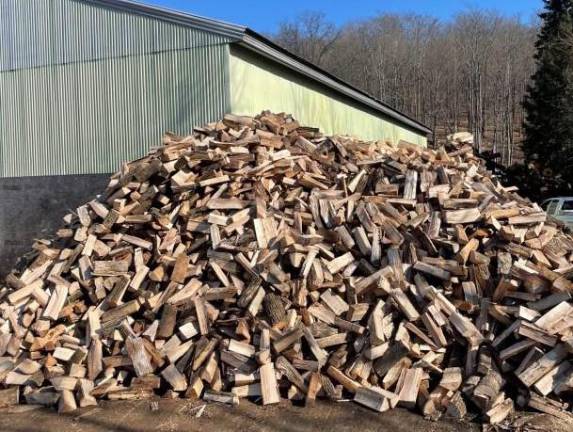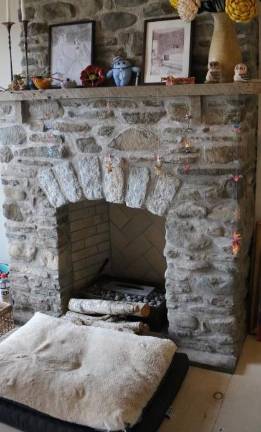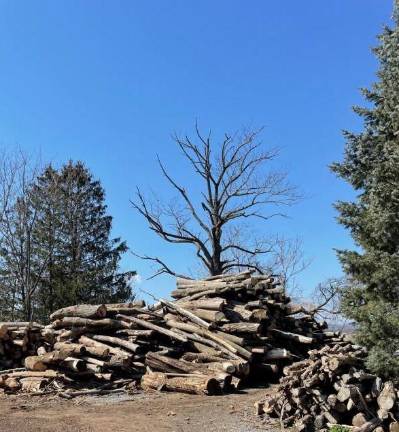‘Wood-burning heat is cheap, but it kills’: Architect and others weigh alternatives
Woodstoves and fireplaces. New York State wants to see a 40% reduction in wood burning to spare hearts, lungs, and brains from particulate pollution. An architect and others in the wood and construction business weigh in on the rural tradition of home fires and consider healthier alternatives.



As prices for natural gas, propane and oil soar, many turn to old-fashioned wood to heat their homes. But there’s a problem.
“Wood-burning heat is cheap, but it kills,” says architect Jeremy Shannon.
Shannon is responsible for energy efficiency in 1,500 New York City school buildings, and is similarly expert in the residential realm.
He and his wife built their Deerpark, N.Y., house largely with their own hands. He continues to cover the outer walls with rocks he collects, but the fireplace burns in a new way, with ethanol, no chimney or wood needed. The fire is for atmosphere, and warmth comes from elsewhere.
Shannon diligently read the 341-page New York State Climate Action Council Draft Scoping Plan, which lays out the logic and methods for minimizing greenhouse gases to help reduce global warming. The Scoping Plan also cites serious but little known health reasons for abandoning wood burning.
Burning wood sends carbon into the air, adding to greenhouse gases. Although accounting for only 8% of greenhouse gases in the state, the 2% of homes that burn wood and other “biomass” for heat generate “more PM2.5 emissions than the power generation sector and the entire transportation sectors combined,” according to the Scoping Plan. Winter wood burning particularly affects air quality in rural areas.
You know you’re in an invisible cloud of PM2.5 when you detect the scent of wood smoke while passing a house. The aroma may be romantic, but what surrounds the house and you, drifting through the neighborhood and beyond, are tiny particles, the largest of which, at 2.5 microns, is 30 times smaller than the width of a hair, according to the NYS Department of Health website. While the upper limits of tolerability and other factors are still being studied, the dangers of PM2.5 are becoming more distinct (please see sidebar).
The New York State Department of Environmental Conservation (DEC), which produced the draft plan, has no plans to penalize wood burning, said spokesperson Haley Viccaro. Rather, the state expects incentives and more efficient heating technology to drive wood burning reduction.
The doubters
For some seeking an alternative heat source, wood has great appeal. Donny Gavoille, of Milford, Pa., said he was just loading his two woodstoves when this reporter called.
“People have been burning wood since the beginning of time,” he said. “I’m not stopping now.”
In Chester, N.Y., a woman expressed doubt about alternatives for heating her old drafty house.
Some businesses, like Timberwolf Tree Service in Warwick, N.Y., rely to various degrees on firewood sales. Rob Scheuermann, owner of RS Landscaping, who also serves as the Village of Warwick tree commissioner, harvests trees for firewood as part of his business.
“The government should let businesses know, or else they’ll be terrified,” Scheuermann said. “The effects of the movement go deep and wide.”
For many, wood-burning stoves can be a lifeline during winter outages that leave people without heat.
Still, Shannon, the architect, sees better options. “A woodstove will only give you heat,” he said. “An outside gasoline generator can supply the power for the heat pump in case of emergency, as well as give you lights and keep your water and refrigerator going.”
He hopes that gas generators will in the future be replaced with battery storage or renewable biofuel systems “to be fully fossil fuel free and keep the air quality in and around the home free of heavy combustion particulates.”
He noted that New York State offers incentives that make new heating technology more affordable. State loan programs, such as New York State Energy Research & Development Authority (NYSERDA) Energy Finance Solutions, and Property Assessed Clean Energy, offer interest as low as 3.75% on up to $25,000 over 15 years, plus rebates that pay 30% to 40% of the cost of work, such as insulation, air sealing, and better windows.
“Those who spend hundreds per month on wood or oil will see similar monthly costs, including loan payments, after the work,” said Shannon, “but they’ll have a healthy living space and help save the environment when energy renovations are designed around saving energy in conjunction with clean heat equipment.”
Better uses for wood
Shannon also predicts a multitude of new green energy jobs. He believes disruptions in wood businesses could be offset by new uses for wood, like wood fiber insulation, that emerge from climate action strategies for construction. Wood insulation production is currently rare in the United States. He also foresees increasing use of 8-by-10-inch beams of laminated heavy timber, as used in barns and old New York City buildings.
“Old growth hardwood isn’t being used now,” he said. “Pine, milled into 10-inch beams, not concrete, is being used for 20-story buildings. It’s a carbon offset. So is taking wood product scraps from other industries to make wood fiber insulation. Fiberglass insulation tears up the lungs of people working with it, and foam board releases refrigerant agents that pollute. Using wood sequesters carbon while saving energy by insulating.”
However, Scheuermann, the Warwick tree commissioner, wonders whether wood insulation businesses will become too numerous and employ too few to compensate for firewood business losses.
Those losses are likely to be gradual. Viccaro, of the DEC, said the Scoping Plan calls for “wood consumption decreases by approximately 40 percent relative to a business as usual projection by 2050, which is the projected decrease due to some New Yorkers deciding on their own to use alternative heating technologies.”
Meanwhile, the expected New York State health cost benefit of the green energy shift is up to $16 billion by 2050, according to the DEC Draft Scoping Plan. Of that, 40% would stem from a 40% reduction in wood burning.
Winter wood burning particularly affects air quality in rural areas. You know you’re in an invisible cloud of PM2.5 when you detect the scent of wood smoke while passing a house. The aroma may be romantic, but what surrounds the house and you, drifting through the neighborhood and beyond, are tiny particles, the largest of which, at 2.5 microns, is 30 times smaller than the width of a hair, according to the NYS Department of Health website. While the upper limits of tolerability and other factors are still being studied, the dangers of PM2.5 are becoming more distinct.